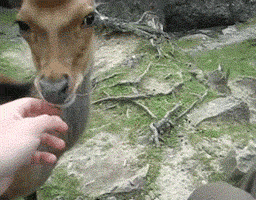
Tie a knot, write a list, whittle a flute, twirl spaghetti round your fork. If you have paws, hooves, wings these maneuvers aren’t in your skill set. Nor are rope, words, knives, or pasta flour. The human hand is perhaps as important in our species’ evolution as our big and highly convoluted brain.
By various measures an elephant’s IQ is quite similar to ours, but look at those flat thunking feet. Their trunk (nose) is their main manipulator. Compare that to a hand’s dexterity and understand the barriers to elephants in developing gadgets or working a chemistry lab.
That said, this blogpost is about one particular use of hands that gets scant scientific airplay: our hands are accomplished communicators. Forget sign language and lovely hula hands — human touch conveys our emotional state to others. We pet dogs and horses, we pet wild animals who’ve been habituated to humans. We make communion across species. No religion meant here, we make communion with others.
You’ve seen instances of animals rubbing necks, seemingly for the same reason. Without hands they agree on a touch that soothes, that amplifies a mammalian sense of peace and love. John and Yoko 101? Actually birds do it, maybe bees do it. Certain fish invite massages in the sea. Does this reach back through the whole vertebrate line?
Because if it does it strengthens the argument that we humans are deeply related to our nonhuman peers. Kindred at a basal level, we can convey comfort, we can share trust. We have a compelling form of Midas’ hands.
![owl being petted [apologies for embedded caption] via https://www.playbuzz.com/jennifers/18-cutest-animal-reactions-to-humans-petting-them?utm_source=pinterest.com&utm_medium=ff&utm_campaign=ff](http://www.sloannota.com/wp-content/uploads/2015/12/owl-petted-33frames.gif)


[youtube]https://youtu.be/dq_apH2y_bk[/youtube]
Mali uromastyx enjoying a belly rub
[youtube]https://youtu.be/eQQEssGL3ZA[/youtube]
A shared moment with a turkey.
_______________________
[youtube]https://youtu.be/XhHy5MppDKE[/youtube]
Not long before this, an eel bit off a diver’s thumb. The diver grabbed for it? Decided to ‘own’ it with his hands?
_______________________

Human hands can speak between souls. That they can also speak across phylums is a glory.
